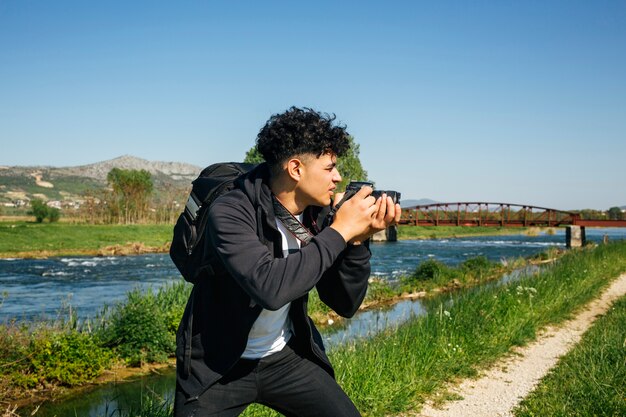The Essential Guide to Journeyman Cameras: Features, Benefits, and Top Recommendations

Introduction
The term journeyman camera refers to a camera used primarily by mid-level professionals in various industries like journalism, videography, or broadcasting. These cameras bridge the gap between entry-level consumer models and high-end, professional cameras. Designed for versatility and durability, journeyman cameras are popular among individuals seeking reliable equipment for shooting high-quality footage without the complexity or cost of professional setups.
In this guide, we’ll dive into the characteristics of a journeyman camera, discuss its features, and explore why it’s essential for intermediate users. We’ll also review some top brands and models, while offering insights into how to choose the right camera for your needs.

Key Features of a Journeyman Camera
A journeyman camera is defined by a set of features that elevate it beyond beginner models but keep it accessible to non-experts. Some of these features include:
1. Interchangeable Lenses
Journeyman cameras often offer the option of interchangeable lenses, providing flexibility to shoot different styles of photography and videography. This feature allows you to switch between wide-angle, telephoto, or macro lenses, which is especially useful for professionals who cover various subjects.
2. Manual Controls
Unlike beginner cameras, journeyman cameras provide greater manual control over settings like aperture, shutter speed, and ISO. This is crucial for those looking to refine their skills and achieve creative shots under different lighting conditions.
3. Durable Build
Cameras in this category are built for rugged environments. Weather sealing, reinforced casings, and ergonomic grips make these cameras ideal for professionals on the move, whether shooting in rain, snow, or extreme heat.
4. High-Quality Sensors
The sensor size is a critical element in any camera. Most journeyman cameras feature APS-C or Micro Four Thirds sensors, which offer high image quality, superior low-light performance, and a shallower depth of field, perfect for creating professional-looking footage.
5. Video Capabilities
Many journeyman cameras come equipped with 4K video recording, high frame rates, and improved autofocus, making them suitable for budding videographers and YouTubers.

6. Advanced Autofocus Systems
A robust autofocus system is a must for professionals who need speed and precision. These cameras often feature dozens of autofocus points and improved subject tracking.
7. Built-In Stabilization
Cameras with in-body image stabilization (IBIS) are common in this category, reducing camera shake and allowing for smoother video and sharper stills, even when shooting handheld.
Unlock a world of fascinating subjects by checking out our other blog posts.
Popular Journeyman Camera Models
Below is a table showcasing some of the most popular journeyman camera models, their specifications, and what makes them stand out in the market.
| Camera Model | Sensor Type | Resolution | Video Capabilities | Stabilization | Price Range |
|---|---|---|---|---|---|
| Canon EOS M50 Mark II | APS-C | 24.1 MP | 4K UHD at 24fps | Digital IS | $699 |
| Sony Alpha A6400 | APS-C | 24.2 MP | 4K UHD at 30fps | None | $899 |
| Panasonic Lumix G85 | Micro Four Thirds | 16 MP | 4K UHD at 30fps | 5-axis IBIS | $800 |
| Nikon Z50 | APS-C | 20.9 MP | 4K UHD at 30fps | Digital VR | $860 |
| Fujifilm X-T30 II | APS-C | 26.1 MP | 4K DCI at 30fps | None | $899 |
| Olympus OM-D E-M5 Mark III | Micro Four Thirds | 20.4 MP | 4K UHD at 30fps | 5-axis IBIS | $1,199 |
Benefits of Using a Journeyman Camera
1. Professional-Grade Quality Without the Complexity
Journeyman cameras offer many features found in professional models but come in a more user-friendly package. For those looking to transition from amateur photography to a professional level, these cameras are the perfect stepping stone.
2. Affordability
While high-end professional cameras can cost thousands of dollars, journeyman cameras offer advanced functionality at a fraction of the cost. This makes them a great option for freelancers, aspiring professionals, or content creators on a budget.

3. Portability
These cameras are typically lighter and more compact than full-frame professional cameras, making them easier to carry around for fieldwork, travel photography, or on-the-go video shoots.
4. Adaptability
With the ability to change lenses and utilize manual settings, journeyman cameras can adapt to a wide range of situations, from street photography to wildlife videography. This adaptability makes them a favorite among professionals who require versatility.
How to Choose the Right Journeyman Camera
Selecting the right camera can be daunting, especially with so many models available. Here are a few factors to consider when making your decision:
1. Budget
Determine how much you’re willing to spend. Journeyman cameras generally fall between $700 to $1,200, so it’s essential to set a realistic budget based on the features you need.
2. Video vs. Photography
If you’re more focused on videography, prioritize a camera with strong video features like 4K recording and high frame rates. For photography, look for features such as a high-resolution sensor and advanced autofocus systems.
3. Lens Compatibility
When investing in a journeyman camera, consider its compatibility with a range of lenses. Some brands, like Canon and Sony, offer extensive lens options, while others, like Fujifilm, have a more limited selection.
4. Portability
If you often travel or need a camera that’s easy to carry, focus on models that are lightweight and compact. Micro Four Thirds cameras like the Olympus OM-D E-M5 Mark III are ideal for their portability without compromising on quality.
5. User Experience
Ease of use is essential for journeyman cameras. Look for models with intuitive menus, customizable buttons, and touchscreen controls to enhance your shooting experience.
Comparison with Professional and Entry-Level Cameras
To better understand where a journeyman camera fits in, it’s important to compare them with both entry-level and professional models.
- Entry-Level Cameras: Often more affordable and aimed at beginners, entry-level cameras have basic features like auto modes and limited manual controls. They are generally not suitable for high-end video production or professional photography, but they are easy to use.
- Professional Cameras: These are more expensive and come with full-frame sensors, ultra-fast autofocus, and exceptional low-light performance. Professional cameras are more complex to operate and require a higher skill level, which is why journeyman cameras serve as a perfect middle ground.
Maintaining Your Journeyman Camera
To get the most out of your camera and ensure it lasts, proper maintenance is crucial. Here are some tips for maintaining your journeyman camera:
- Clean the Lens Regularly: Dust and smudges can affect the quality of your images. Use a soft microfiber cloth or a lens cleaning kit to keep it spotless.
- Protect from Extreme Weather: Even though journeyman cameras are built to be durable, it’s best to avoid exposing them to extreme weather for extended periods. Use protective gear like a camera bag or cover when shooting in harsh conditions.
- Battery Care: Make sure your batteries are stored at the correct temperature, and avoid letting them completely drain frequently to extend battery life.
- Firmware Updates: Stay updated with the latest firmware releases for your camera. These updates often improve performance and add new features.
Frequently Asked Questions (FAQs)
1. What is a journeyman camera?
A journeyman camera refers to a mid-level camera used by semi-professional photographers and videographers. It offers advanced features without the complexity of professional models, making it ideal for intermediate users.
2. Can a journeyman camera be used for professional work?
Yes, many journeyman cameras are equipped with features like 4K video recording, manual controls, and interchangeable lenses, making them suitable for professional-grade work.
3. What is the price range of journeyman cameras?
Journeyman cameras typically range from $700 to $1,200, offering a balance between affordability and advanced functionality.
4. What sensor types are found in journeyman cameras?
Most journeyman cameras come with APS-C or Micro Four Thirds sensors. These sensors offer great image quality and allow for better low-light performance compared to entry-level models.
5. Do journeyman cameras support 4K video recording?
Yes, many journeyman cameras, such as the Sony Alpha A6400 and the Panasonic Lumix G85, offer 4K video recording, making them great for content creators and videographers.
6. Are journeyman cameras good for beginners?
While journeyman cameras offer more features than beginner models, they can still be a good choice for ambitious beginners looking to grow their skills.
7. What is in-body image stabilization (IBIS)?
IBIS helps reduce camera shake, which results in sharper images and smoother videos, especially in handheld shooting.




